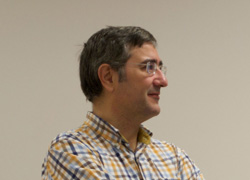IMDEA Networks

Archives: Events
Mobility – Background, State-of-the-art, Challenges and Approaches
Mobility is, without doubt, one of the major new paradigms of the current Internet, and this is driving most of the research activity in networking throughout the World. We are gradually evolving from a network where most end-systems have a fixed or quasi-fixed point of attachment, towards a global network where end systems seamlessly move from network to network and where networks themselves change their connection point to the Internet. In spite of this there is still a long way to go before user and network mobility – at IP level – become a reality, as several technological and research challenges persist.
Read more arrow_right_altDesign and Evaluation of a robust delay-based congestion protocol
Many delay-based congestion protocols have been proposed. Some recent studies have questioned the validity of congestion prediction at end hosts Based on measurement studies. In this talk, we show that end-host based delay prediction can be more accurate than previously characterized. We propose PERT (Probabilistic Early Response TCP) to mitigate the uncertainties in end-host based congestion prediction. PERT emulates the behavior of AQM/ECN in the end hosts' response to congestion.
Read more arrow_right_altRouting for Energy Minimization in the Speed Scaling Model
The problem is interesting for two reasons. First, the cost function closely models the energy consumption of some network elements and network-wide optimization is a well-motivated but under-explored direction for energy minimization. Second, it brings light to a challenging combinatorial optimization problem. We will present positive and negative results for polynomial functions and polynomial functions with startup cost. For the latter, techniques to accomplish better-than-polynomial approximation ratios independent of demands and cost function remains a challenging problem.
Read more arrow_right_altEnergy Efficient Ethernet (IEEE 802.3az): Performance Evaluation
Energy consumption in Computer Networks is an issue that is gaining increasing attention. In this talk we will review the issue of energy consumption in Computer Networks to then focus on Ethernet where a new standard is being developed to improve energy efficiency. We will discuss some of the alternatives that were considered during the Energy Efficient Ethernet standardization process and describe the solution adopted in the standard. Then we will present some results of an initial performance evaluation of the standard that shows the potential savings for different scenarios. We will conclude the talk by outlining the implications that Energy Efficient Ethernet will have on different aspects of the LANs.
Read more arrow_right_altComputing: A small step from Classical to Quantum
The Theory of Computing is almost a hundred year old now. Its roots can actually be traced to the Entscheidungsproblem posed by David Hilbert in 1928. Another concrete theory in Physics called the Quantum Mechanics had its inceptions almost two hundred years ago (with Thomas Young's Double Slit Experiment in 1803) but actually started in the late 19th century. Today, Quantum Mechanics is proven to be the most successful theory of Physics. So the natural question to ask was that while the statement of Church-Turing Thesis is seen to be a statement of physics (laws of nature), then it should be compatible with the theory of Quantum Mechanics!
Read more arrow_right_altCloud elasticity at a flat fee
Existing cloud computing platforms offer virtually unlimited compute resources (virtual machines, bandwidth, storage, etc.) that can be used on demand. Such on-demand model offers significant elasticity to the customers in terms when and where they use the resources. The existing pricing model, however, is pay-as-you-go which in turn can lead to unpredictable costs to the cloud customers. This talk will discuss two adaptive approaches for resource control under a fixed budget: Distributed Rate Limiting (DRL) and Temporal Rate Limiting (TRL). DRL is a fully decentralized mechanism for resource control over a distributed cloud service, that splits the available budget among the participating nodes subject to the load each node experiences. TRL in contrast, splits the budget over a time period, to optimize the performance of the customer with demand pattern that varies in time.
Read more arrow_right_altThe GeoNet Final Workshop
The GeoNet consortium invites you to attend its final workshop as a unique opportunity to learn more about IPv6 geonetworking and the link between IPv6 geonetworking and the related ITS development in CAR 2 CAR Communication Consortium, CVIS implementation and ETSI TC ITS standardization. During the workshop you will get information through communications and posters and also see the system working in real cars. Please find the program in attachment with practical details (exact place, registration procedure...).
Read more arrow_right_altSecurity and non-cooperative behavior in wireless networks
According to most technology pundits, progress in wireless and sensor networks will lead us into a world of ubiquitous computing, in which myriads of tiny, untethered sensors and actuators will communicate with each other. Information technology will thus deliver its most encompassing and pervasive accomplishment to mankind, promptly taking care of the needs and wishes of everyone.
Read more arrow_right_altAnalysis and Experimental study of operational 802.11-based Wireless Mesh Networks
The performance of IP flows in Wireless Mesh Networks is unfairly biased by the unplanned compounding behavior of MAC and transport protocols. This compounding protocol behavior can undesirably result in complete starvation of some flows and in consistent capacity reductions originated by, e.g., limited volumes of control traffic.
Read more arrow_right_altThe pain of doing research with real (wireless) devices
A lot of attention has been given to multihop wireless networks lately. This attention has motivated an increase in the number of 802.11-based deployments, both indoor and outdoor, used to perform measurement studies to analyze WLAN performance by means of wireless sniffers that passively capture transmitted frames. In this talk talk we will introduce some of the major issues that systems researchers have to address when performing such measurements: i) on one hand, the testbed itself requires a significant amount of resources during both its deployment and its maintenance, and they require a "calibration" phase before running the experiments given that as off-the-shelf devices have recently been shown to deviate from the expected behavior--in this talk we summarize a few lessons learned from the deployment of a 28-node wireless testbed; ii) on the other hand, little attention has been given to the fidelity of an individual device, i.e., the ability of a given sniffer to capture all frames that could have been captured by a more faithful device. We assess this fidelity by running controlled experiments, and show that it varies significantly across sniffers, both quantitatively and qualitatively.
Read more arrow_right_alt











Recent Comments